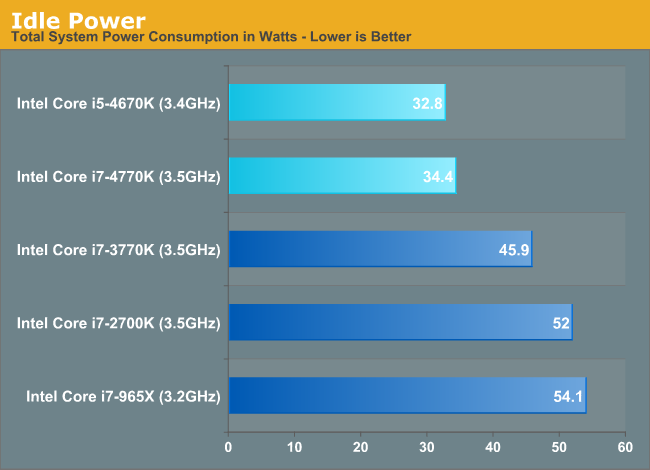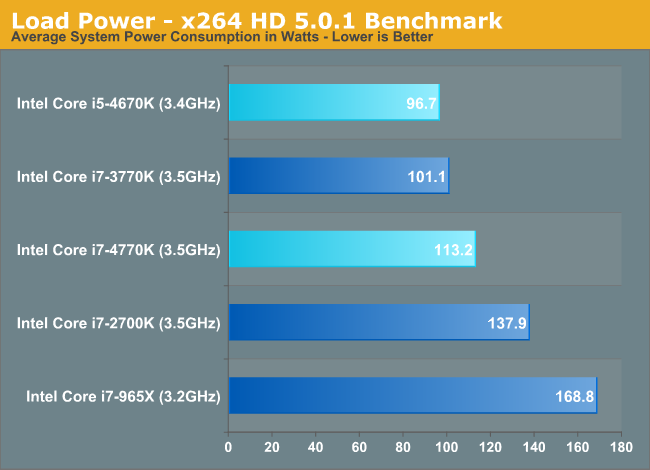The Haswell Review: Intel Core i7-4770K & i5-4670K Tested
by Anand Lal Shimpi on June 1, 2013 10:00 AM ESTPower Improvements
Although Haswell’s platform power is expected to drop considerably in mobile, particularly with Haswell U and Y SKUs (Ultrabooks and ultrathins/tablets), there are benefits to desktop Haswell parts as well.
There’s more fine grained power gating, lower chipset power and the CPU cores can transition between power states about 25% quicker than in Ivy Bridge - allowing the power control unit to be more aggressive in selecting lower power modes. We’ve also seen considerable improvements on lowering platform power consumption at the motherboard level as well. Using ASUS’ Z77 Deluxe and Z87 Deluxe motherboards for the Haswell, Ivy and Sandy Bridge CPUs, I measured significant improvements in idle power consumption:

These savings are beyond what I’d expect from Haswell alone. Intel isn’t the only one looking to make things as best as can be in the absence of any low hanging fruit. The motherboard makers are aggressively polishing their designs in order to grow their marketshare in a very difficult environment.
Under load, there’s no escaping the fact that Haswell can burn more power in pursuit of higher performance:

Here I’m showing an 11.8% increase in power consumption, and in this particular test the Core i7-4770K is 13% faster than the i7-3770K. Power consumption goes up, but so does performance per watt.
The other big part of the Haswell power story is what Intel is calling FIVR: Haswell’s Fully Integrated Voltage Regulator. Through a combination of on-die and on-package circuitry (mostly inductors on-package), Haswell assumes responsibility of distributing voltages to individual blocks and controllers (e.g. PCIe controller, memory controller, processor graphics, etc...). With FIVR, it’s easy to implement tons of voltage rails - which is why Intel doubled the number of internal voltage rails. With more independent voltage rails, there’s more fine grained control over the power delivered to various blocks of Haswell.
Thanks to a relatively high input voltage (on the order of 1.8V), it’s possible to generate quite a bit of current on-package and efficiently distribute power to all areas of the chip. Voltage ramps are 5 - 10x quicker with FIVR than with a traditional on-board voltage regulator implementation.
In order to ensure broad compatibility with memory types, there’s a second input voltage for DRAM as well.
FIVR also comes with a reduction in board area and component cost. I don’t suppose this is going to be a huge deal for desktops (admittedly the space and cost savings are basically non-existent), but it’ll mean a lot for mobile.
No S0ix for Desktop
You’ll notice that I didn’t mention any of the aggressive platform power optimizations in my sections on Haswell power management, that’s because they pretty much don’t apply here. The new active idle (S0ix) states are not supported by any of the desktop SKUs. It’s only the forthcoming Y and U series parts that support S0ix.










210 Comments
View All Comments
AmdInside - Sunday, June 2, 2013 - link
I am actually more interested in the new 8 series chipsets than Haswell. I have a Sandybridge work desktop and Ivybridge gaming desktop and would switch my Sandybridge motherboard if the chipset were backwards compatible with SB CPUs.Klimax - Sunday, June 2, 2013 - link
Just reminder: We are more or less out of free performance without new algorithms or massive complexity/power consumption. (There are limits to what we can do)And Intel engineers won't increase complexity of chips. (Otherwise they'd have their own version of GPU problems)
Anyway, waiting for Haswell-E... (Could use AVX2, but don't wont to lose 6 cores of 3930k)
ashetosvlakas - Sunday, June 2, 2013 - link
"As we’ve seen in the past, the K-series parts (and now the R-series as well) omit support for vPro, TXT, VT-d, and SIPP from the list."As this is the official Haswell review and since TSX are not included in the K-series parts, I believe this is a huge omission from the review, especially since transactional memory is a revolutionary technology with a lot of potential. I find the lack of mention misleading and it should be corrected as soon as possible.
KAlmquist - Sunday, June 2, 2013 - link
Thanks for letting us know this. Checking the specifications on ark.intel.com, I find:i5-4430 no TSX
i5-4570 has TSX
i5-4670 has TSX
i5-4670K no TSX
i7-4770 has TSX
i7-4770K no TSX
So TSX is missing from half of the current Haswell models (ignoring the low power S and T chips). So far we only have quad core chips; I expect that TSX will be missing from most of the dual core chips. It doesn't seem that TSX is intended to be used by developers writing general purpose code.
Kougar - Sunday, June 2, 2013 - link
Is 2016 the earliest we will see Haswell-E launch?Buying a 4770K means I'm wasting 33% of the die on a GPU I don't want, and because it's a "K" chip it will also lose VT-d capability. Six-core "K" chips retain VT-d support, but buying SB-E seems silly given Haswell offers much better IPC and single-threaded performance, and later even against IB-E it would feel like paying more for less.
Intel has taken a perpetual 2-year break between updating its high end, so if IB-E launches Q4'13 then it seems Q4'15 would be the earliest Haswell-E will show up?
Charlesm1950 - Sunday, June 2, 2013 - link
Haswell GT3e graphics come at what price? Certainly a lot more than Haswell GT2 or Richland A10 graphics. And Intel is right, Haswell GT3e graphics beats old, entry level discrete graphics cards. BUT, Haswell does not do DUAL GRAPHICS! Pair a Haswell with a dGPU and you get only the graphics horsepower of the dGPU. In short, you waste all that die area that Intel devoted to GT3e and eDRAM. On the other hand, pair a AMD Richland A10 with a dGPU and both GPUs work in tandem to give performance scores well beyond Haswell GT3e and for dare I say a lot less money. That's true even with the cheapest entry level Radeon GPU. So, Intel has created a monster graphics engine and put memory on the die - but to claim its free or the best solution is just being a fan boy for Intel.monohouse - Sunday, June 2, 2013 - link
this my friends, is a joke, the mighty Haswell K models will not support VT-x, LOL this is going to be the first nail in Intel's coffin in favor of AMD, and I bet AMD are going to take advantage of this (and they already take advantage of Intel's "K" marketing strategy - why buy an incredibly expensive Intel "K" model without VT-x support, when you can buy an AMD both unlocked and with VT-x support) (the joke is that a 5-year old Core 2 Duo has more to offer than the latest and greatest Intel parts [it supports VT-x]). I am running a 4300 mhz Wolfdale (Penryn) and an another 3000 mhz Conroe, none of what I see here (and in part due to the lack of VT-x support) from Haswell is of any significant enough value over my current hardware, I would have considered it if I had a Pentium 4, but even then I would rather go to the AMD side, since they present no obstacles.and I still have many functional PCI cards and I am not about to throw them away just because Intel decided not to support them (yet another nail in Intel's coffin) (in my opinion hardware has to comply with the user's wishes, not the other way around).
skrewler2 - Monday, June 3, 2013 - link
Wait, what? The K series doesn't include VT-d support, I don't see anything saying they don't support VT-x.BillyONeal - Monday, June 3, 2013 - link
Your comment doesn't make sense. AMD chips obviously don't have VT-x support; they have a competing standard, AMD-V. The first generation of virtualization extensions didn't make much of a dent in perf. The larger gains came as a result of SLAT which both AMD and Intel added around the Nehalem timeframe.monohouse - Sunday, June 23, 2013 - link
but SLAT is not going to be available on K models because virtualization is disabled ?